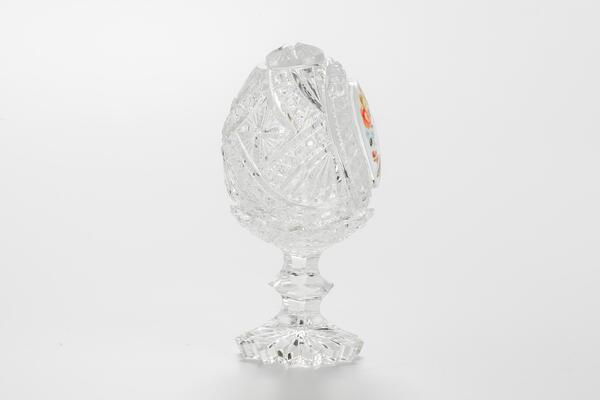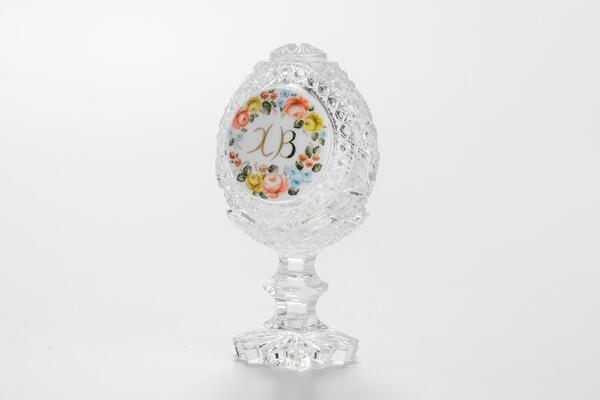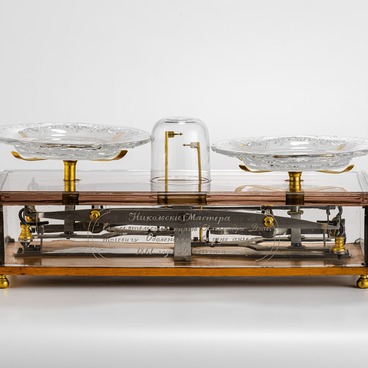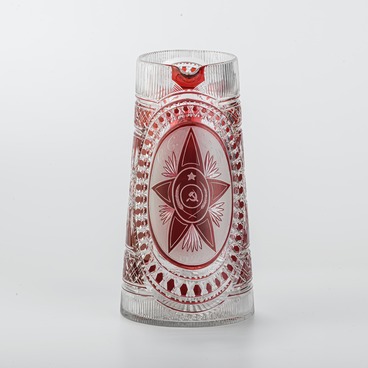Before the revolution, most products of the Nikolsko-Bakhmetevsky factory were intended for Church use. The factory had its own tradition of manufacturing Easter eggs. After the revolution, the religious objects were no longer produced at the factory. It was not until the late 20th and early 21st centuries that the glass blowers resorted to the extensive museum collection in search of new forms.
During that time, the museum’s staff prepared specific exhibitions of everyday tableware dating back to the beginning of the previous century. As a result, the Red Giant factory resumed the production of incense burners, Easter eggs and other Church objects and symbols of religious feasts.
In 1999, Easter eggs were mass produced at the factory, yet the return to the traditions had happened somewhat earlier. In 1989–1991, the factory artist Olga Nikolaevna Shorokhova designed two variants of Easter gifts. The first one was a classical Easter egg made from two-layer glass and decorated with elaborate cutting. The second variant was an egg on a stand hand decorated in the diamond cutting technique, painted and gilded.
This Easter egg is an example of the factory reviving its Easter traditions. The hollow blown egg and the stand are made from colorless crystal. The surface is decorated with different kinds of deep cutting. The stand is a bowl on a faceted stem with a cut-out round base. The egg features a milky medallion. Inside the medallion is a polychrome wreath of roses and forget-me-nots with the letters “ХВ” (Christ has Risen) in the middle. Since the pre-revolutionary times, the technique of decorating glassware with painting and gold has been considered a distinctive feature of the Bakhmetevsky factory products. The design is distinguished by lightness, purity of shades, and lack of excessive details.
The flowers painted by the artist are not only decorative — they also have a symbolic meaning. Red roses traditionally symbolize love, bright yellow ones — joy. Blue forget-me-nots are a symbol of purity, truthfulness and constancy of feelings. Both types of flowers are ancient Christian symbols.
During that time, the museum’s staff prepared specific exhibitions of everyday tableware dating back to the beginning of the previous century. As a result, the Red Giant factory resumed the production of incense burners, Easter eggs and other Church objects and symbols of religious feasts.
In 1999, Easter eggs were mass produced at the factory, yet the return to the traditions had happened somewhat earlier. In 1989–1991, the factory artist Olga Nikolaevna Shorokhova designed two variants of Easter gifts. The first one was a classical Easter egg made from two-layer glass and decorated with elaborate cutting. The second variant was an egg on a stand hand decorated in the diamond cutting technique, painted and gilded.
This Easter egg is an example of the factory reviving its Easter traditions. The hollow blown egg and the stand are made from colorless crystal. The surface is decorated with different kinds of deep cutting. The stand is a bowl on a faceted stem with a cut-out round base. The egg features a milky medallion. Inside the medallion is a polychrome wreath of roses and forget-me-nots with the letters “ХВ” (Christ has Risen) in the middle. Since the pre-revolutionary times, the technique of decorating glassware with painting and gold has been considered a distinctive feature of the Bakhmetevsky factory products. The design is distinguished by lightness, purity of shades, and lack of excessive details.
The flowers painted by the artist are not only decorative — they also have a symbolic meaning. Red roses traditionally symbolize love, bright yellow ones — joy. Blue forget-me-nots are a symbol of purity, truthfulness and constancy of feelings. Both types of flowers are ancient Christian symbols.





